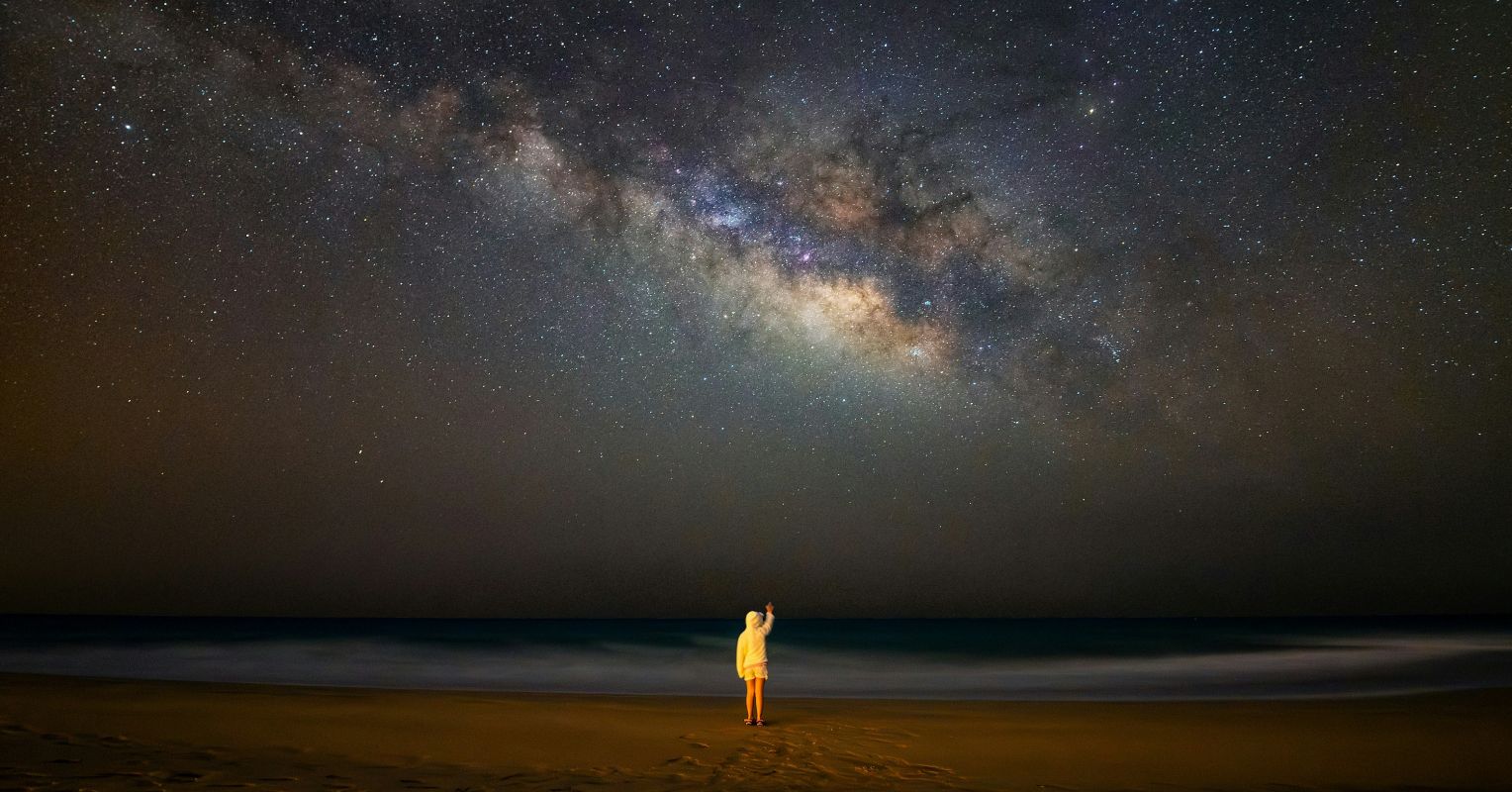[ad_1]

This essay was co-authored by Artemisia O’bi and Fan Yang
As we journey alongside life, we encounter plenty of ups and downs, and at totally different factors alongside the way in which, we additionally discover ourselves in moments that profoundly transfer us. A few of these are awe experiences: occasions once we understand issues so huge that they transcend our current understanding of the world, they make us overlook about our ordinary considerations, take us past the boundary of ourselves, and really feel astonished by and linked to the world.
However what do these moments really feel like once they occur in childhood? From what level in life can we recognize awe?
We began to consider youngsters’s perceptions of awe within the early months of 2020, simply because the COVID-19 pandemic was coming into view. On the time, our exterior world was changing into more and more constrained, with widespread faculty closures and lockdowns, but the 4-to-9-year-old children we labored with within the Human Nature and Potentials Lab — a developmental psychology analysis heart on the College of Chicago — remained simply as open and stuffed with surprise as ever. The distinction was palpable.
Our conversations started to swirl across the imaginative and resilient nature of youngsters. We thought in regards to the potential for early awe experiences to affect youngsters’s worldview and perhaps even their sense of self. We questioned whether or not or not youngsters seen the distinction between moments of awe and other forms of on a regular basis moments in life and the way these perceptions may have an effect on them. These questions led us to design new research to raised perceive the emergence of awe in childhood.
Adults Recognize Awe
Analysis on adults has proven that awe experiences induce the sensation of perceiving one thing huge that transcends one’s present understanding, and plenty of historic and non secular texts word the centrality of awe in peak experiences. There may be even analysis that theorizes how awe might have helped our ancestors survive all through historical past.
Regardless of plenty of totally different research displaying that adults react positively to awe, little analysis has checked out awe-inspiring experiences early in life.
Some individuals might doubt children’ capability to understand awe. Since awe is normally talked about within the context of a profound expertise, it may very well be the case that awe is a posh subjective state that solely emerges with substantial life expertise and knowledge. We acknowledged this chance, however individuals who spend ample time with youngsters can let you know that they give the impression of being out on the world with eager eyes and massive curiosity. They discover and enjoyment of what could appear mundane to us as adults.
Due to this fact, we tinkered with the concept that awe can also be a deeply rooted human expertise — one which may very well be appreciated even in childhood.
Finding out Kids’s Sense of Awe
We began by taking a look at youngsters’s responses to totally different types of awe to see if they’d differentiate between awe-inspiring and on a regular basis experiences.
In our first research, we confirmed youngsters a video of optimistic, lovely nature scenes excerpted from the BBC’s “Planet Earth” and requested them to check it to a video displaying on a regular basis scenes of small vegetation rising in an unusual yard backyard. After watching every video, youngsters reported that they considered themselves as smaller after watching the awe-inspiring video than after the on a regular basis video. They shared that they’d love to look at the awe video once more. Additionally they felt extra motivated to discover and perceive unknown issues.
In our subsequent research, youngsters even reported comparable emotions in response to a video of pure catastrophe imagery in comparison with unusual yard backyard imagery. This helps the view {that a} sense of awe could be elicited not solely by optimistic experiences but in addition by unfavourable or threatening huge experiences, akin to these involving perceptually huge pure disasters.
These findings recommended that youngsters perceived a distinction between awe-inspiring imagery and on a regular basis imagery, and we discovered ourselves asking: If youngsters might understand awe, what sort of affect may awe-inspiring moments have on their sense of self?
Awe’s Impact on Sense of Self
We turned our consideration to the consequences awe might have on youngsters’s sense of self — their understanding and feeling of who they uniquely are.
We designed a research to see if youngsters may reply in a different way to awe-inspiring nature imagery versus awe-inspiring social imagery, akin to scenes of huge teams of individuals. Based mostly on analysis displaying how giant crowds could make individuals really feel trivialized and de-individualized, we thought that massive crowds may evoke awe, however won’t carry a couple of optimistic sense of self.
We confirmed youngsters the identical lovely nature movies from the primary research, together with movies of massive crowds shifting by metropolis streets. We requested them comparable reflection questions from our first research and included extra inquiries to discover the impact of the imagery on their sense of self.
We discovered a number of optimistic results of the huge nature video on youngsters’s sense of self. The character scenes have been extra probably than the group scenes to steer youngsters to suppose past their ordinary wants and wishes. Additionally they made youngsters really feel extra able to bettering their very own lives and extra distinctive.
Awe Is available in Many Varieties
At the least three forms of awe-inspiring imagery have gotten a variety of consideration in science and have been researched in grownup research: huge nature, threatening pure disasters, and depictions of objects at an uncommon scale, akin to microscopic photographs or objects shifting in sluggish movement.
We in contrast youngsters’s responses to imagery of every of those three classes of awe to these of on a regular basis scenes. We requested new questions in regards to the youngsters’s emotions of awe, worry, and pleasure, in addition to their familiarity with the pictures.
All three forms of imagery led to a higher sense of awe than the on a regular basis imagery and elevated youngsters’s motivation to study new issues. These findings confirmed that it’s not only one class of awe that has these sorts of results. In actual fact, there are many totally different sorts of awe — many greater than we might check — that will have the potential to encourage and encourage youngsters to suppose and act in a different way.
Embracing Awe From Early in Life
Our research make clear youngsters’s perceptions of the distinction between awe experiences and other forms of on a regular basis moments. And this distinction influences their sense of awe, pleasure, and worry, together with their motivation to discover, consciousness of issues to know, and facets of their sense of self.
Regardless that awe experiences are advanced and profound, it appears we do not need to attend till we’re grown-ups to understand them. As a substitute, we’re given the present of sensitivity to awe even in our childhood, which we supply onward into life as we’re frequently impressed.
These findings underscore the worth of nurturing awe in childhood. Concurrently, they immediate reflection for each grownup: Are we dropping our deeply rooted means to seek out and recognize awe? Amidst our busy lives, maybe we should always keep in mind that we have been all as soon as youngsters ourselves, and all of us have the potential to expertise the world’s awe-inspiring magnificence in appreciative methods.
[ad_2]
